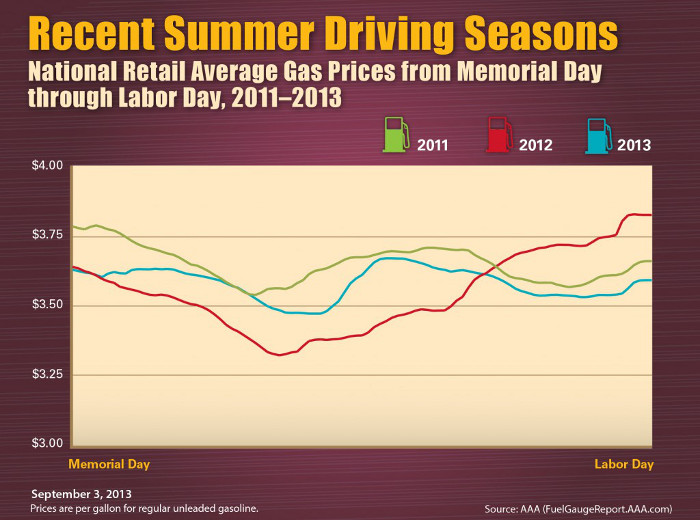AAA Fuel Gauge Report: Summer Prices Were Third Highest on Record
WASHINGTON, D.C. – Drivers paid the third-most expensive gas prices -- an average of $3.58 per gallon of regular gas -- during this year's summer driving season, which took place Memorial Day through Labor Day. The record remains $3.95 in 2008, followed by $3.65 in 2011, according to the latest AAA Fuel Gauge Report.
While last year's national average hit higher prices at the beginning and end of the summer, prices also fell to a less-expensive summer low of $3.33 on July 2, 2012, compared to a low of $3.47 on July 7 of this year.
Additionally, the weekly national average gas price rose to $3.59 per gallon as of Sept. 3, the fourth-highest price on record for the calendar date, following $3.66 in 2011, $3.68 in 2008 and $3.83 in 2012, which was also the all-time high. The current price is 5 cents more expensive than one week ago, but 3 cents less than a month ago and 24 cents less than a year ago. The discount from last year also marks the largest year-over-year disparity since May 7.
Just 1 percent of U.S. gas stations are selling gas for more than $4 per gallon, compared to one year ago when 16 percent were selling gas for more than that price. Thirty-seven percent of gas stations are selling gas for less than $3.50 per gallon, compared to 2 percent last year.
The five states with the highest average gas prices per regular gallon are: Hawaii ($4.31), Alaska ($4.02), Connecticut ($3.94), New York ($3.87) and California ($3.83). The five states with the lowest average prices are: South Carolina ($3.28), Mississippi ($3.36), Alabama ($3.37), Arizona ($3.38) and Virginia ($3.38).

During the month of August, the national average price fell approximately 3 cents per gallon, or 1 percent, to $3.57, the fourth-highest average on record for the month. The August average was $3.77 per gallon in 2008, $3.69 per gallon in 2012 and $3.62 per gallon in 2011, according to the AAA Monthly Gas Price Report for August.
"Motorists paid significantly lower gas prices than recent years in August as most refineries ran smoothly and no hurricanes threatened production," said AAA spokesman Avery Ash. "There are more than sufficient gasoline supplies for current demand, which has kept prices somewhat stable despite concerns about violence in the Middle East."
Oil prices remain high due to geopolitical tensions in the Middle East and North Africa, but retail prices have not moved markedly higher due to being largely offset by comfortable domestic gasoline supplies, lagging demand and a so-far weak Atlantic hurricane season, AAA said.
This year marks the first time in more than 10 years that no Atlantic hurricane has appeared through the end of August, and it may mark the latest date for a hurricane to form during the satellite era. The current record is 2002, when Hurricane Gustav officially reached hurricane status on Sept. 11. However, if the National Oceanic and Atmospheric Administration's 2013 forecast for a more active than usual hurricane season holds true, there is still the potential for higher retail gas prices in the future if storms affect gasoline production and distribution.
"Gasoline prices usually drop with the end of the summer driving season, but it is impossible to say whether this will be a typical year given the potential risks facing the market," Ash continued. "Escalating tensions in the Middle East and North Africa, possible U.S. action in Syria or a major hurricane could make it more expensive to buy gas, while a relatively calm month should send prices much lower. It is too soon to know how these factors might affect motorists in the coming weeks."
Gas prices have declined during the last four out of five Septembers at an average of 8 cents per gallon due to lower demand and the switch to less-expensive winter-blend gasoline. In 2012, gas prices dropped approximately 5 cents per gallon during September. This year's winter-blend switchover is scheduled to begin Sept. 15.

